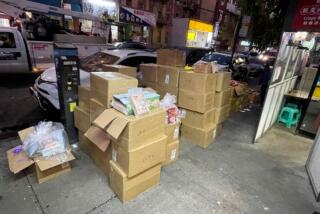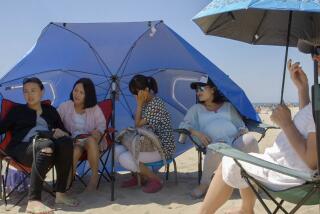Chinese tourists’ spending in the U.S. takes off
Minutes after arriving by bus at an outlet mall in Cabazon, a dozen or so Chinese tourists hustled out to buy luggage that they planned to stuff with high-end clothes, shoes and bags.
But not Guoshing Cui, a Samsung supervisor from Guangzhou. He made a beeline for the Coach store, where he picked out three expensive handbags. He paid more than $800 from a wad of $100 bills.
The bags were gifts for family and friends in China, where Coach goods sell for two to three times the price in the U.S. “It’s a smart move,” he said of his purchases.
That kind of power shopping has made the Chinese tourist the highest-spending overseas visitor to the U.S. and one of the most valued customers for U.S. outlet malls, shopping centers and tour bus operators.
Chinese tourists spend an average of $2,932 per visit to California, compared with $1,883 for other overseas visitors, according to the latest statistics by the U.S. Office of Travel and Tourism Industries. A big chunk of their spending — about 33% — goes for gifts and souvenirs.
“What we know about Chinese visitors is they don’t like to lay on the beaches,” said Ernest Wooden Jr., president of the Los Angeles Tourism and Convention Board. “What they do like is shopping.”
The outpouring of Chinese money helped set a record for spending by foreign visitors to the U.S. — $168.1 billion in 2012, according to federal officials. Los Angeles is getting its share of the Chinese spending: Nearly 1 in 3 Chinese travelers to the U.S. makes a stop in the City of Angels.
“The Chinese middle class is growing and their No. 1 destination is L.A.,” said Los Angeles Mayor Antonio Villaraigosa, who has made two trips to China and will be in Beijing this week to promote trade and travel with L.A.
China’s relatively strong economy and its growing middle class means more Chinese citizens have money to travel and spend, according to tourism experts. The middle class in China numbered 247 million people in 2011, or 18% of the population, and is projected to grow to more than 600 million by 2020.
Visitors to California from China are typically professionals, executives or managers, with an average annual income of $66,900 — compared with an annual per capita income of about $5,000 for all Chinese residents, according to statistics from the U.S. and Chinese governments.
To draw in more Chinese spending, store owners, hotel managers and tour guides in Southern California are going out of their way to welcome Chinese tourists.
At the Desert Hills Premium Outlets in Cabazon, 20 of the 130 stores employ Mandarin-speaking salesclerks such as Jeffrey Hsu, who works at the mall’s Ugg Australia store.
“I think we understand their customs,” Hsu said. “When someone comes to a foreign country they want to bring back gifts for their family and friends.”
Spending by Chinese travelers has grown so fast in the last few years that it has surpassed the per capita outlays of other high-spending visitors, including travelers from Japan, Australia, Brazil and South Korea.
The customs and unique characteristics of the local economy shape how foreign visitors spend their time and money when visiting the U.S.
Australians, for example, share a similar culture with the U.S. and are more likely than other overseas travelers to visit museums, art galleries and historical sites.
“We are fascinated by peoples of different cultures,” said James McKay, an engineer from Melbourne, whose recent visit to the U.S. included tours of Alcatraz island in San Francisco, the Pearl Harbor memorial in Hawaii and ground zero in New York. He also took a historic tour of Disneyland with his wife, Karen.
Japanese tourists, according to travel surveys, spend heavily at restaurants because certain foods, particularly red meat, are much more expensive in the island nation.
That may explain why Morton’s steakhouse in Beverly Hills has become hugely popular among Japanese tourists.
“Don’t even put fish or chicken in front of them,” Joanna Sanchez, a spokeswoman for the restaurant, said of Japanese visitors. “They come for steak.”
But Chinese tourists tend not to shop for themselves. Most of their purchases — usually high-end clothes and accessories featured in American movies and magazines — are gifts for friends and family.
Chinese tourists in the U.S. target brands such as Coach, Ugg, Polo, Nike, Tommy Hilfiger, Neiman Marcus and L’Occitane. Steep Chinese taxes make such brands two to three times more expensive in China, said Helen Koo, president of America Asia tours in Monterey Park.
“Many tourists feel that the savings more than pay for the entire trip,” she said.
Many Chinese visitors also stock up on vitamins in the U.S. because they are suspicious of the quality of supplements sold in China.
To stretch their travel budgets, Chinese tourists prefer shopping at outlet malls.
“We see many visitors head to the luggage store, get a suitcase and then it’s, ‘OK, we are going to fill the bag,’” said Michele Rothstein, a senior vice president at Simon Property Group, one of the country’s largest operators of regional and outlet malls. “The Chinese are definitely seen as speed shoppers.”
During a recent visit to the U.S., Ding Sheng, a tourist from Guangzhou, China, said he took a tour to Rodeo Drive in Beverly Hills and was planning to see the casinos of Las Vegas and the Grand Canyon. But he said a shopping outing to the Cabazon outlet mall was the highlight of the trip.
“These are gifts for my friends,” he said as he shopped for Ugg shoes, priced at $149 a pair.
Although Chinese tourists spend heavily on gifts and souvenirs, the travelers typically skimp on food and lodging, tour guides say.
For example, the tour group that chartered a bus to the Desert Hills Premium Outlets stayed about 75 miles away at an economy hotel in the city of Industry and ate at Chinese buffet restaurants in the San Gabriel Valley.
“Even when they stay at a cheap hotel, they spend a lot on shopping,” said Nathan Xue, a tour guide for TPI America.
In fact, the Chinese travelers spent so much during the visit to the outlet mall that it took Xue an extra hour after his recent tour bus was scheduled to leave to pull the Chinese tourists away from the stores.
And when the shoppers finally returned to the bus, it took another 20 minutes for them to stuff their bulging bags of clothes, shoes and luggage into the bus’ cargo hold.






